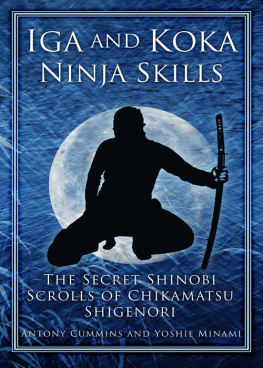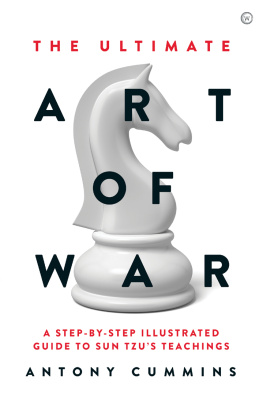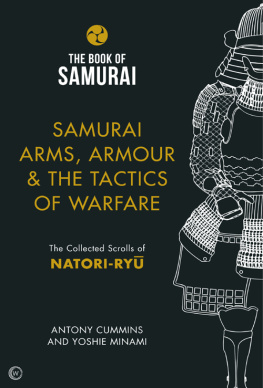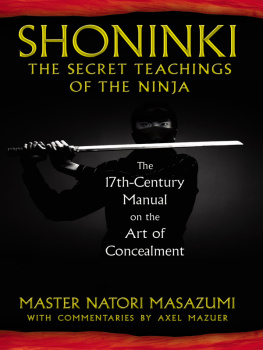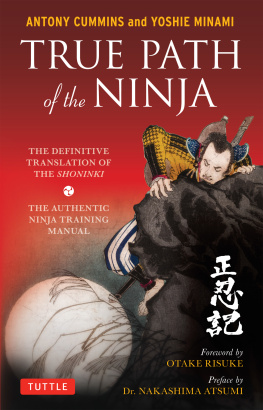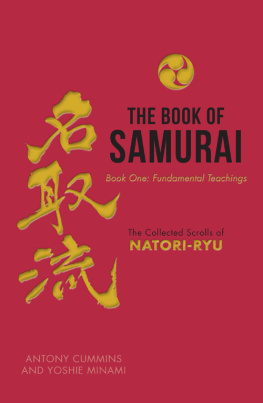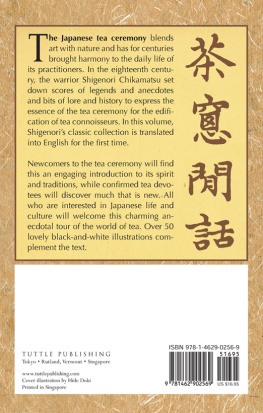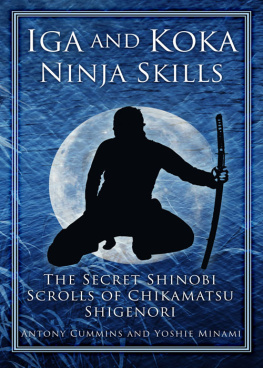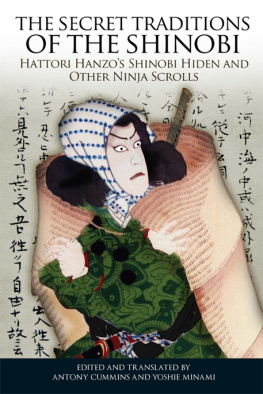CONTENTS
This book could only be dedicated to Chikamatsu Shigenori himself, who, in his foresight collected the secret traditions of Iga and Koka for the education of all who follow this path.
A special thank you must be given to Kevin Aspinall who posed for some of the images and to Mr Takashi Shimizu for his aid with some of the more unintelligible sections of the text. Also, my thanks to Jayson Kane for his vast efforts with the images and illustrations and lastly to Jackie Sheffield and Shaun Barrington for their editorial help.
This document was written on the fifteenth day of the first lunar month in the period of Kyoho Four (1719). Also, all of the important points from Hara Yuken Yoshifusas [ninja] scroll and the associated oral traditions have been passed on and have all been given, together with a certificate of qualification [to Chikamatsu, the transcriber of these words].
Koka Shinobi no Den Miraki
This single passage above initiated my search for the elusive ninja scroll of the shinobi named within it. To my bitter disappointment, the shinobi Hara Yuken Yoshifusa was nowhere to be found, nor was his text, making what was a great lead for a full Koka ninja manual a dead end, or so I thought. That was until I considered that maybe, just maybe, the scroll was not under his name and that the information found within it was also recorded in one of Chikamatsu Shigenoris own scrolls. Chikamatsu Shigenori was a tactician-scholar (more on him later) who continued devotedly to record ancient and military ways, so my thought process was, why would he not transfer this information into his own scrolls? This led me to hunt down his more obvious military texts, the ones listed under his schools, such as Zen-ryu and Ichizen-ryu, but after scroll upon scroll and search upon search, there was nothing to be found. It was, again, with a flash of inspiration that I knew I been looking in the wrong place, I had been searching for a title only, so I changed my angle and found a listing of his major and extended works, all collected under his name, which contained around 150 scrolls, and lo and behold, there it was, glimmering among the black ink of the other titles The Use of Spies.
To find some of the ninja scrolls of yore, you have to put yourself in the position of a writer of the medieval period and take note that the word shinobi is not considered a positive one in the world of Edo-period Japan. However, Yokan The Use of Spies is a reference to Sun Tzus thirteenth chapter in The Art of War and that chapter of this famous text contains the Five Chinese Spies where there are the Five Types of Spy, surely the shinobi will follow. The reasoning paid off; document number in hand, I and my translation partner, Yoshie Minami, ordered copies of four of Chikamatsus scrolls that appeared to have this spy theme.
Waiting in the dark streets of Warabi, Japan, I saw Yoshie approaching and we moved on to a traditional English tea shop, a local haunt where many of our translations are completed. After a pot of tea and the usual cake I could contain myself no longer and Yoshie produced the now familiar red and white envelope that a certain university send their documents in. Beaming, she said it is full of shinobi information. Hours and more tea later, she had read through the titles and given a brief explanation of most of the points found in the manuals. I sat back, knowing the day would come in the not too distant future where I would be writing this introduction, knowing that my happiness would spill on to this page.
But the fairy tale does not end there; the scroll quoted at the beginning of this introduction was a scroll from the area of Koka, as the words were being said by the Koka ninja Kimura. However, to my pure delight, Chikamatsu, in a wondrous turn of events, had not only recorded most of the Koka traditions, he had also studied with a master shinobi of the Iga line and recorded and compared the two traditions. Words cannot express the satisfaction of such a find, not only do we have a reputable figure in Japanese history, and not only did he learn and record the written and oral traditions of the shinobi, but in his foresight collected both the traditions of Iga and Koka, the premier spies of all of Japan. Eerily, in his own introduction he states that his recording of these very secret skills was for posterity and for the future study of those to come who follow the path of the shinobi, but not in his wildest dreams would he have considered that they would be here in English, the language of the world, to be studied across the globe.
It is with great pleasure that Yoshie and I present to you the collected shinobi skills of Iga and Koka and a commentary on Sun Tzus Use of Spies, compiled and taught by Chikamatsu Shigenori a ninja treasure beyond price.
Antony Cummins, 2013
CHIKAMATSU SHIGENORI
Famous for tea and the tea ceremony, the image of Chikamatsu in the west is considered from the wrong angle. When searching for information on his life, often the primary focus is put on the only other work of his published in English, Stories from a Tea Room Window a text on curiosities pertaining to tea which is often followed up with He was also known to be a military tactician. This is a skewed vision of a man who can be considered one of Japans premier Edo period military scholars who also happened to like tea. However, what is buried even deeper in the historical mist is Chikamatsus connection to the shinobi, Japans spies, now known as ninja.
When reading any Edo period military scholars work on the science of warfare from Japan, you will almost always find references to shinobi, but again, almost all of the time this is a brief instruction on how to use shinobi or how to defend against them, containing no more than a few paragraphs. Chikamatsu on the other hand is a licensed master of a full Koka ninja tradition and also a student (if not a master) of the shinobi arts of Iga. Master Kimura of Koka awarded Chikamatsu a Kyojou licence, confirming that he had a full transmission of the scrolls, complete with all of the oral traditions, making him an instructor of shinobi no jutsu the arts of the shinobi. However, we must not fall into the trap of placing him solely in the realms of the shinobi, Chikamatsu also had licences or instruction in many other military and classical arts, such as poetry and Shinto, and overall was a man dedicated to the study of warcraft.
According to the Shirinsokai, the official record of the samurai of Owari province, Chikamatsus grandfather, Chikamatsu Shigehide, started his service for the third inheritor of the Owari Tokugawa clan, Lord Mitsutomo, at an unknown date before 1664. He became the magistrate overseeing two districts and held the office of magistrate of the water supply (mizu Bugyo), a position of importance. The Owari Tokugawa clan were one of the three great houses of Tokugawa, alongside Kii (Kishu) and Mito Tokugawa. His son, Chikamatsu Shigekiyo, who was Shigenoris father, entered into the service of the Owari clan in 1691 and later became the head of craftsmanship and controlled the lumber for the lords residences in Edo. He died in 1732.

Chikamatsu Shigenori was born in 1697, the name he was most commonly known by was Hikonoshin. He was also known as Renpeido (after his training hall) and Nogenshi. At the age of sixteen, in 1712, he entered the service of the Lord Tokugawa Yoshimichi as an Otoriban (a form of page or helper) and was transferred to the lords residence in Edo in 1713. At this point he put on a demonstration for the lord and performed Iai (sword quick draw) from Katayama-ryu, also Takanao-ryu military arts, Shinnen ryu staff fighting, and other military ways. The lord was greatly impressed and promoted him, bringing him to his side as a close retainer. The lord had an enthusiasm for the martial arts and had the aspiration to found a school called Zen-ryu 

